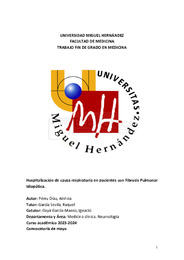Por favor, use este identificador para citar o enlazar este ítem:
https://hdl.handle.net/11000/33748Hospitalización de causa respiratoria en pacientes con Fibrosis Pulmonar Idiopática.
| Título : Hospitalización de causa respiratoria en pacientes con Fibrosis Pulmonar Idiopática. |
| Autor : Pérez Díaz, Ainhoa |
| Tutor: García Sevilla, Raquel Gayá García-Manso, Ignacio |
| Editor : Universidad Miguel Hernández |
| Departamento: Departamentos de la UMH::Medicina Clínica |
| Fecha de publicación: 2024-05-01 |
| URI : https://hdl.handle.net/11000/33748 |
| Resumen : Introducción: La Fibrosis Pulmonar Idiopática (FPI) es una enfermedad pulmonar intersticial fibrosante crónica que se asocia a una caída de la función pulmonar progresiva y a un pobre pronóstico. El curso clínico de la FPI es heterogéneo, desde formas estables en el tiempo, a fallo respiratorio progresivo o a la presentación de exacerbación aguda (EA). La “International Working Group Proyect” propuso en 2016 (1) unos criterios diagnósticos de EA en pacientes con FPI y los definió como idiopáticos o secundarios a un trigger (infecciones virales, quimioterapia, cirugía torácica, radioterapia). Las hospitalizaciones son muy frecuentes en estos pacientes y se asocian a alta mortalidad y deterioro de la calidad de vida, especialmente cuando se deben a EA y requieren cuidados en unidades de críticos o ventilación mecánica. Objetivo: Analizar los ingresos por causa respiratoria en pacientes con FPI en los dos años siguientes al diagnóstico. Métodos: En el estudio se han incluido 88 pacientes diagnosticados de FPI entre 2009 y 2021 en el Hospital General Universitario Dr. Balmis de Alicante. Se han recogido los datos y se ha analizado de forma retrospecYva la causa neumológica de los ingresos, el tratamiento de la EA y la evolución de los pacientes con FPI. Resultados: De los 88 pacientes incluidos, se objetivaron 82 ingresos de causa respiratoria durante los 2 primeros años de seguimiento. De estos ingresos, la EA representa el 43,9%, seguido de la progresión de la enfermedad, con un 31,7%. Los pacientes que no han exacerbado presentaban al diagnóstico una capacidad vital forzada (FVC) media de 2414,8 ± 793,67 mL y 76,9 ± 21,4 %, con una capacidad de difusión del monóxido de carbono (DLCO) media del 51 ± 18,74%. Los que han presentado alguna exacerbación durante los dos años siguientes al diagnóstico, tenían al inicio una FVC media de 1971,3 ± 568,77 mL y 66,9± 19,1 %, con una DLCO media del 38 ± 11,91%. Se han encontrado diferencias estadísticamente significativas en la FVC y DLCO entre pacientes con EA y sin EA (p<0,05). Para el tratamiento de la EA, se utilizaron bolos de corticoide en el 69,4% de los pacientes frente al 30,6% con corticoide a dosis de 1 mg/kg. Un total de 17 pacientes fallecieron por causa neumológica, 7 de ellos por EA. Conclusiones: La EA es la causa neumológica más frecuente de ingreso en pacientes con FPI en los dos años siguientes al diagnóstico. La EA es la causa neumológica de éxitus más frecuente en estos pacientes. Introduction: Idiopathic Pulmonary Fibrosis (IPF) is a chronic fibrosing interstitial lung disease associated with progressive lung function decline and poor prognosis. The clinical course of IPF is heterogeneous, ranging from stable forms over time, to progressive respiratory failure or the presentation of acute exacerbation (AE). The "International Working Group Project" proposed in 2016 (1) diagnostic criteria for AE in IPF patients and defined them as idiopathic or secondary to a trigger (viral infections, chemotherapy, thoracic surgery, radiotherapy). Hospitalizations are very frequent in these patients and are associated with high mortality and deterioration of quality of life, especially when they are due to AE and require care in critical care units or mechanical ventilation. Objective: To analyze admissions due to respiratory causes in patients with IPF in the two years following diagnosis. Methods: The study included 88 patients diagnosed with IPF between 2009 and 2021 at the Hospital General Universitario Dr. Balmis in Alicante. Data were collected and the pneumological cause of admissions, treatment of AE and evolution of patients with IPF were retrospectively analyzed. Results: Of the 88 patients included, 82 admissions for respiratory causes were observed during the first 2 years of follow-up. Of these admissions, AE accounted for 43.9%, followed by disease progression, with 31.7%. Patients who did not exacerbate had a mean forced vital capacity (FVC) of 2414.8 ± 793.67 mL and 76.9 ± 21.4% at diagnosis, with a mean carbon monoxide diffusing capacity (DLCO) of 51 ± 18.74%. Those who had presented any exacerbation during the two years following diagnosis had at baseline a mean FVC of 1971.3 ± 568.77 mL and 66.9± 19.1 %, with a mean DLCO of 38 ± 11.91%. Statistically significant differences were found in FVC and DLCO between patients with AE and without AE (p<0.05). For treatment of AE, corticosteroid boluses were used in 69.4% of patients versus 30.6% with corticosteroid at a dose of 1 mg/kg. A total of 17 patients died of pneumological causes, 7 of them from AE. Conclusions: AE is the most frequent pneumological cause of admission in patients with IPF in the 2 years following diagnosis. AE is the most frequent pneumological cause of death in these patients. |
| Palabras clave/Materias: fibrosis pulmonar idiopática exacerbación aguda ingresos hospitalarios corticoides mortalidad |
| Área de conocimiento : CDU: Ciencias aplicadas: Medicina |
| Tipo de documento : info:eu-repo/semantics/bachelorThesis |
| Derechos de acceso: info:eu-repo/semantics/openAccess Attribution-NonCommercial-NoDerivatives 4.0 Internacional |
| Aparece en las colecciones: TFG- Medicina |
 La licencia se describe como: Atribución-NonComercial-NoDerivada 4.0 Internacional.
La licencia se describe como: Atribución-NonComercial-NoDerivada 4.0 Internacional.
.png)
